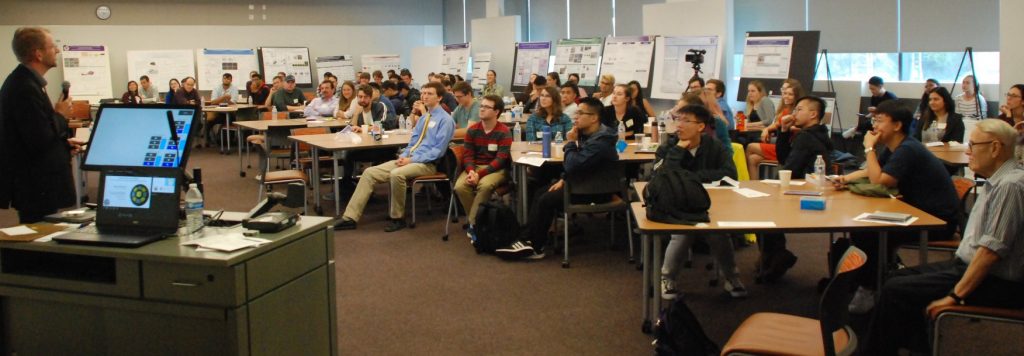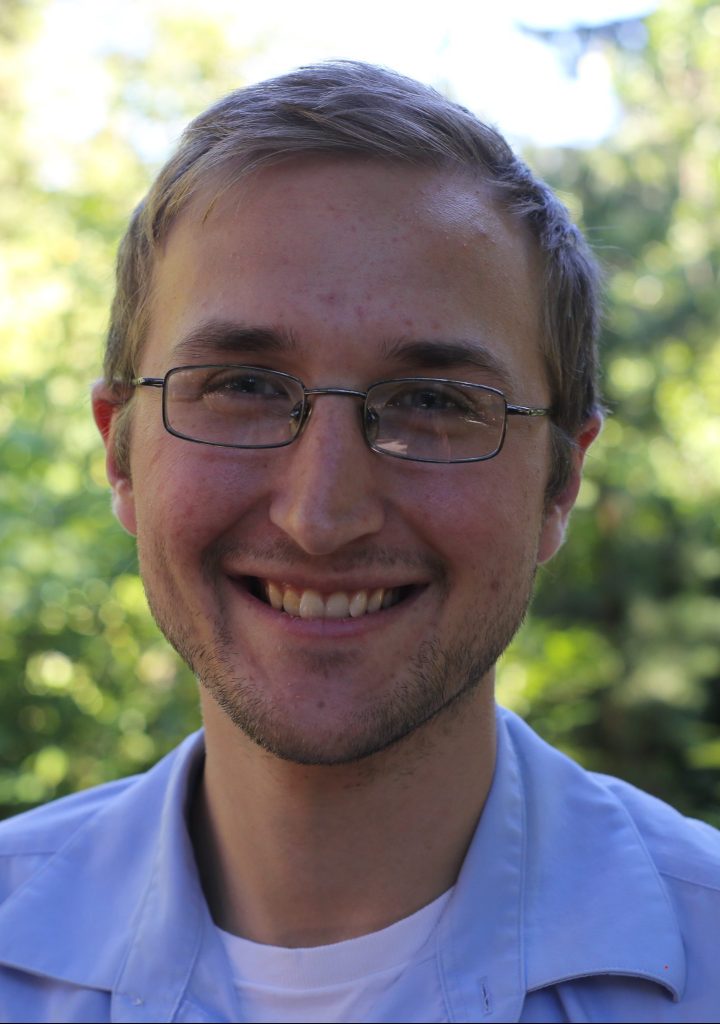2022 Graduate Student Symposium

About the Event
The 2022 GSS will be held September 22nd, 2022 from 1:00 pm to 6:00 pm PST.
The Graduate Student Symposium (GSS) bridges the gap between industry and academia. The event is a daylong seminar held as a means for students to share their research with colleagues, faculty, and representatives from industry. It also serves as a forum in which students can practice their presentation skills to a highly interdisciplinary audience and gain valuable feedback from people both in and outside of academia. The event includes an industry keynote speaker, panel discussion, as well as student talks and posters to showcase the latest research in biotechnology, energy, materials engineering, and data science
For the past fourteen years, the GSS has become a vital forum for both graduate students and industry representatives. With over 100 graduate students, faculty, and industry participants this event provides a chance to learn about the innovative research conducted at the University of Washington, meet future research leaders, and help improve the quality of graduate education in the Chemical Engineering department.
Even though we would love to conduct the event fully in person, all invited speakers will be given the option to participate remotely through video conference. This is to reduce non-essential traveling and respect everyone’s comfort level with in-person gatherings. If possible, the symposium will take place on campus, but a remote attendance option will be provided. The in-person option will follow the State’s and University’s current regulations for gatherings at the time of the event
Format and Schedule
The event will be held in person, with the exception of the industry panel and student oral presentations, which will be held in a hybrid format and will be digitally accessible via the Zoom link below for remote attendees. All activities are listed in Pacific Daylight Time (PDT).
In person location: NanoES Building – Room 181, 3946 W Stevens Way NE, Seattle, WA 98105
Agenda
- 1:00 – Opening Remarks
- 1:05 – Keynote Speaker:
- Dr. Charles Jones, Pfizer
- 2:00 – Student Presentation Session I
- 2:30 – UW ChemE Alumni Award Presentation
- 2:50 – Break
- 3:00 – Student Poster Session I
- 3:45 – Industry Panel
- Jade Hudson – Blue Origin
- Dr. Janet Matsen – Benchling
- Dr. Jon Witt – Recurrent
- 4:30 – Student Presentation Session II
- 5:00 – Student Poster Session II
- 5:50 – Closing Remarks
Help us judge student presentations!
Please fill out this form to help us score the presenters in Student Presentation Session I/II.
For in-person attendees:
The in person option for the event is only possible because of explicitly defined COVID related safety measures. Please read carefully the below guidelines, failure to follow them will not be tolerated.

For remote attendees:
For remote attendees: There will be three Zoom links to participate in the keynote speech, industry panel session and two oral student presentation sessions. Two of our panelists will join us remotely, and all students giving oral presentations will have their presentation slides displayed via Zoom. Please check below for meeting links:
Keynote Speech: https://washington.zoom.us/j/96767066893
Industry Panel: https://washington.zoom.us/j/91014398213
Graduate Student Oral Presentation Session(s): https://washington.zoom.us/j/94980488000
Keynote Speaker:
Dr. Charles Jones

Dr. Charles Jones is the Senior Director of mRNA Commercial Strategy & Innovation at Pfizer, where he is responsible for driving strategic initiatives for the development of the mRNA platform. He also serves the commercial co-lead for Pfizer’s next generation mRNA influenza (flu) vaccine portfolio and continues to be an
internal technical expert of RNA and innovative delivery technologies.
Dr. Jones has been with Pfizer since 2019 and has held roles in Corporate Strategy, Marketing and Commercial Development. During this time, Dr. Jones has contributed to several high-profile projects including the initial rollout of the Pfizer-BioNTech COVID-19 Vaccine before becoming one of the original members of the newly formed mRNA team at Pfizer.
Prior to joining Pfizer, Dr. Jones spent time as an entrepreneur, where he was a co-founder and CEO of a biotech company dedicated to the development of “smarter” vaccines against commensal bacteria such as S. pneumoniae. After a successful exit, Dr. Jones spent time in consulting where he specialized in pipeline strategy and new product launches. Dr. Jones holds a B.S in Chemical Engineering and a B.S. in Biochemistry from North Carolina State University, a Ph.D. in Chemical Engineering from the University of Buffalo, and an MBA from the University of Chicago Booth School of Business.
Cross-Disciplinary Panel
Jade Hudson – Blue Origin

Jade Hudson is currently the Director of Production Engineering dedicated to Advanced Development Programs at Blue Origin.
Jade has 30 years of aerospace experience managing multi-skill teams in manufacturing, process development, and process improvement projects. Her technical and leadership roles have included overseeing aerospace manufacturing operations, leading design/build integration teams, and directing new product development projects. Jade has also managed a variety of material technology teams, specializing in Chemicals, Metals, Composites, and Non-destructive Inspection, Assembly, and most recently Production Engineering. Jade is passionate about people development and has led many skill team activities. She has demonstrated the ability to lead in challenging environments while being driven to achieve results.
Jade holds a bachelor’s degree in Chemical Engineering and a master’s degree in Environmental Engineering, both from the University of Washington.
Outside work, Jade enjoys cooking, hiking and gardening. Her daughter Kaylee is current an engineering student at UW. Her husband recently retired from the Boeing Company and has been active in many environmental preservation activities in the community.
Dr. Janet Matsen – Benchling
Dr. Jon Witt – Recurrent

Jon Witt is a junior data scientist at Recurrent Auto, a fully remote start-up founded in Seattle that can in short terms be described as the CarFax for electric vehicles. At Recurrent, Jon’s work contributes to accelerating the adoption of used electric vehicles. As a data scientist at Recurrent, Jon develops data pipelining tools and explores machine learning algorithms to assess the degradation of electric vehicles as a function of calendar (time) and cycle (use) aging. While data science is now his main role at Recurrent, in his first two years Jon has also handled roles in customer success, marketing, and sales support. Along with his co-workers and ChemE Alumni, Dr. Brian Gerwe and Dr. Blake Hough, Jon co-authored a successful NSF Phase I SBIR grant for Recurrent, in which he was the lead investigator for ground truthing our machine learning models.
Student Speakers
-

Diego Alba
Carothers lab
Multi-layer CRISPRa/i circuits for complex genetic programs in prokaryotic systems -

Luke Elkhoury
Berg Lab
The effect of curing schedules on fiber-matrix adhesion in carbon fiber–epoxy resin composites -

Jeremy Filteau
Nance Lab
Organotypic Whole Hemisphere Brain Slice Models to Study the Effects of Age and Oxygen-Glucose-Deprivation on the Extracellular Properties of Cortical and Striatal Tissue -

Rachel Ware
Mittal Lab
Data science integration with kidney images: a step towards accurate and comprehensive disease diagnosis.
Help us judge student presentations!
Please fill out this form to help us score the presenters in Student Presentation Session I/II.
Poster Sessions
Session I
Sequence-Tunable Materials for Silica Biomineralization
Kaylyn Torkelson
Marchand Research Group – Xenobiology lab: Expanding nucleic acid technology with xenonucleic acids
Hinako Kawabe
Nucleic acids are the building blocks of life as we know it. With just four bases, DNA encodes for the 20 standard amino acids and performs complex biochemistry. Xenonucleic acids (XNAs) are nucleic acid analogues that expand the biochemical space we have access to. While multiple XNAs have been previously developed, the Marchand Lab works with XNAs that are structurally similar to the standard bases; our goal is robust incorporation of these XNAs into synthetic biology. This poster will outline the tools we must develop to utilize XNAs in synthetic biology, including sequencing methods and engineered organisms. We also highlight some future applications and additional directions in XNA work, including enzymatic synthesis of XNAs and genetic code expansion.
Novel approaches for multi-input & dynamic CRISPRa/i circuit functions in cell-free systems
Ryan Cardiff
The ability to reconstruct complex, input-responsive expression behaviors in synthetic gene circuits will enable sophisticated information processing, with implications for biosensing, biocomputation, and metabolic engineering. In this work, we engineer conditionally-responsive CRISPR systems in E. coli based cell-free systems, including the blue light-responsive EL222 system and small molecule-responsive abscisic acid (ABA) and gibberellic acid (GA) systems for incorporation into regulatory networks.
Room-temperature Synthesis of Metals Sulfides for Battery Applications
Kevin Lee
Neonatal pharmacokinetics and biodistribution of polymeric nanoparticles
Nuo Xu
Open-Hardware Materials Acceleration Platforms for Accessible and Democratized Materials Discovery
Maria Politi
We present two high-throughput workflows implementing low-cost and open-hardware based materials acceleration platforms (< $15k), using commercially available materials, and adopting open-science principles for the exploration of soft matter systems involving large chemical design spaces. The first platform addresses the synthesis of deep eutectic solvents (DESs), a novel class of designer solvents with appealing properties for various applications. A wide range of candidate organic precursors (>105) could be used to form DESs with variable properties, leading to a vast design space, which remains largely unexplored. To tackle such a challenge, we have demonstrated the development and use of high-throughput DES formulation workflows and data-driven design strategies for automated synthesis, rapid evaluation, and screening of physical and electrochemical properties. We further synthesized and characterized 600 DES candidate combinations to evaluate their potential use as redox flow battery electrolytes. The second workflow investigated the sonochemical synthesis of CdSe quantum dots and magic-sized clusters at 625 unique sample conditions, including variations in precursor ratios and ligand concentrations. We implemented a configurable and open-source automation platform for sonochemical applications, based on a repurposed 3D-printing platform (Jubilee) with tool-changing capabilities, in combination with an Opentrons OT-2 liquid handling robot and microplate readers for a fully automated workflow, from sample synthesis to characterization. The experimental campaign took less than 2 weeks, making it significantly faster than the traditional, low-throughput hot-injection method. We subsequently use a data-driven approach to corroborate the qualitative relationships observed from the samples’ optical characterization. These accessible and affordable systems would enable most laboratories to adopt them with limited funding. Moreover, reduced volumes that are as low as 0.5 mL per sample, allow for cost-efficient and environmentally friendly experimental procedures. Finally, the flexibility, modular nature, and reconfigurability of these high-throughput platforms, makes them adaptable to a variety of soft matter formulation studies
Brain-Derived Extracellular Vesicles: Molecular Probes and Therapeutic Vehicles in the Neonatal Ischemic Brain
Phuong Nguyen
Abstract: Hypoxic‐Ischemic Encephalopathy (HIE) in the brain is the leading cause of morbidity and mortality in neonates, to which there is no cure. HIE is characterized by a reduction of adequate cerebral blood flow that can lead to permanent brain damage. Brain repair after HI requires highly coordinated injury responses mediated by cell‐derived extracellular vesicles (EVs). Due to their ability to regulate immune response, EVs have emerged as important players in neuronal development and proliferation within the brain. In contrast to standard in vitro cell culture models, we successfully isolated and characterized endogenous EVs from rat brain tissue (BEV) to study their therapeutic potential in an ex vivo HI model. We demonstrated that BEVs significantly decreased cytotoxicity in an OGD brain slice model in a dose‐ and time‐dependent manner. The minimum therapeutic dosage of BEVs was 25μg, 48h is the therapeutic exposure time, and the therapeutic application time window is 4–24h post‐injury. BEV treatment significantly increased anti‐inflammatory IL-10 cytokine expression in OGD slices. The morphology of microglia in OGD slices was observed to shift from an amoeboid, inflammatory phenotype to a restorative, anti‐inflammatory phenotype following 24–48h incubation with BEVs. BEVs play a promising role in significantly attenuating inflammation and cytotoxicity in HIE neonatal models. From a clinical perspective, studying the brain’s response to endogenous EVs following ischemic injury is a first step to understanding how therapeutic EV payloads can improve outcomes for neonatal HIE patients.
Mittal Research Group – Comprehensive Cancer Management Through Imaging, Genomics, and Artificial Intelligence
Rachel Ware
The Mittal group uses bioimaging and machine learning methods to gain new insights in the molecular and spatial disease profiles. We also build digital models on existing medical images for more comprehensive diagnosis and disease management. The current projects focus on digital identification of immune cells on breast cancer tissue, histological and diagnostic modeling of kidney tissue, and spatial profiling of molecular markers in cancer. In addition to data science, we are developing multiplexed spectral imaging tools, to identify molecular targets on cancer samples, enabling multi-dimensional spatial profiling that will not only guide precision diagnosis but also open new opportunities for treatment especially immunotherapy.
Hillhouse Research Group – Forecasting the Decay of Hybrid Perovskite Solar Cells with Machine Learning
Spencer Cira
The poster will go over the main research efforts of the group that are centrally founded in understanding the important chemistries present in perovskite solar cells and utilizing these understandings along with in-situ device data to predict the lifetime of these devices with machine learning.
Carothers/Zalatan Research Group – Advancing CRISPR-Cas transcriptional programs in bacteria
Ava, Karanjia
CRISPR-Cas transcriptional tools have been widely applied for programmable regulation of complex biological networks. In comparison to eukaryotic systems, bacterial CRISPR activation (CRISPRa) has stringent target site requirements for effective gene activation. We have bypassed some of these limitations through PAM-flexible dCas9 variants, multiple transcriptional activator configurations, and promoter engineering. Our work provides a framework to choose CRISPRa machinery components for a given set of gene targets, which will expand the utility of CRISPRa/i gene regulation in bacterial systems. We will also be highlighting future directions and applications of our transcriptional tools including: single cell RNA sequencing, CRISPR-Cas translational programs, biocontainment strategies, and bacterial therapeutics.
Session II
EUV Resist Development through Rapid Screening of Hybrid Molecular Layer Deposition Films
Duncan Reece
Xenomorph: nanopore sequencing of xenonucleic acids
Hinako Kawabe
At the molecular level, all life on earth is governed by simple building blocks including the four nucleic acids in DNA. Xenonucleic acids (XNAs) are DNA base analogues that expand the biochemical space that is biologically accessible. One of the major barriers to XNA work in synthetic biology is the lack of commercially available sequencing. Nanopore sequencing is a next-generation sequencing method that is based on current measurements; in this work, we aim to parametrize a model to sequence four different XNAs using nanopore data. First, we sequence a known library of XNA containing sequences and use these measurements to build our model. We design a package called Xenomorph, which processes the raw nanopore data and calculates the outlier-robust maximum log-likelihood to output the most likely base at a given position. While different sequence contexts give variable accuracy, we find that a consensus read gives over 95% accuracy for all four of our XNA bases. Using Xenomorph, we hope to explore many future directions in XNA sequencing, including additional model building and investigation of XNA retention in vivo.
Bergsman Research Group
Claire Benstead
Metal Sulfide Nanomaterials as Templates for Heterostructure Formation and Aggregative Growth
Zach Wylie
Probing mechanisms of microstructural remodeling using nanotechnology in organotypic whole-hemisphere brain slice models
Brendan Butler
This work seeks to begin expanding upon prior findings of differences in nanoparticle diffusive behavior in varied biological environments. We take a closer look at the structural, micro-rheological and biochemical influences on nanoparticle fate in the brain microenvironment. Nanoparticles are tracked via live video fluorescence microscopy in brain slices subjected to engineered stimuli. We juxtapose tissue tracking experiments with tracking in engineered hydrogel models to isolate and explore specific influences on particle behavior as well as better calibrate tissue-based particle tracking measurements. The development of this analysis pipeline will enable particle-based mechanistic studies of combinatorial disease states, such as the susceptibility to neurodegeneration following traumatic brain injury.
Diagnostic Tool to Estimate Half-Cell Properties from Fuel-Cell Battery Experiments
Rose Lee
Development of a Python-based tool to non-destructively disaggregate individual electrode contributions to the full-cell response to advance next-gen batteries.
Oral Presentation Abstracts
Multi-layer CRISPRa/i circuits for complex genetic programs in prokaryotic systems
Diego Alba
CRISPR-Cas transcriptional circuits hold great promise as platforms for engineering metabolic networks and information processing circuits. However, there are limited examples of complex prokaryotic circuits, mainly due to the difficulty of sequentially combining a limited set of components into multi-layer operations. Here, we develop design principles for engineering prokaryotic CRISPRa/i genetic circuits with network topologies specified by guide RNAs. We first demonstrate that multi-layer CRISPRa/i cascades and feedforward loops can operate through the regulated expression of guide RNAs in a prokaryotic cell-free expression system. We then design an expandable set of high-performing synthetic promoters and guide RNAs to enable assembly of more complex topologies. We engineer novel synthetic promoters with up to 1000-fold dynamic range, constituting a 33-fold improvement from previous promoters. With these new components, we build up to six-layer deep circuits and demonstrate the regulation of up to 9 different genes connected in series and in parallel. Overall, this work provides a toolbox and establishes a framework for building scalable CRISPRa/i circuits as regulatory programs in cell-free expression systems.
The effect of curing schedules on fiber-matrix adhesion in carbon fiber–epoxy resin composites
Luke Elkhoury
Fiber-reinforced polymeric composites are used in a large and growing number of applications, all requiring different property sets including the nature of the fiber-matrix adhesion to which the present work is addressed. Specifically, the number of curing cycles, curing temperature and schedule, degree of cure, use of accelerants, annealing, and the use of fiber handling agents are investigated for systems of Hexcel IM7 carbon fibers embedded in Epon862 (resin) and Epikure Curing Agent W (hardener) using the single-fiber fragmentation method. The fractional extent of cure is monitored using differential scanning calorimetry (DSC), so that comparisons are made at the same degree of cure (99%). Single-stage curing at the highest temperature produces the highest apparent adhesion, and the use of accelerants significantly increases the curing rate while maintaining the same level of adhesion. Accelerants in some cases, however, decrease the plastic yield strength of the specimens. Annealing reduces induced residual stress and apparent adhesion, but not below the baseline achieved at lower curing temperatures. Plastic yield strength and apparent adhesion decrease for any degree of cure lower than 95%, while the use of handling agents shows no effect on adhesion.
Organotypic Whole Hemisphere Brain Slice Models to Study the Effects of Age and Oxygen-Glucose-Deprivation on the Extracellular Properties of Cortical and Striatal Tissue
Jeremy Filteau
Chronic diseases are the leading cause of death and disability, affecting 6 in 10 adults in the United States. Developing novel therapeutics is necessary to combat chronic disease and reduce this burden, but the process to take a drug from discovery to marketplace is slow and costly. Failure to translate outcomes in animal models to success in human clinical trials is a major contributor to the time and cost associated with bringing drugs to market and is in part due to the inability of animal models to recapitulate the physiology of the disease in question. 2D in vitro cell culture models are simple and inexpensive, but lack contact between neighboring cells and native tissue architecture. Organotypic slice models have advantages over primary cell culture, as multicellular interactions are retained and bias in cell type is eliminated. Additionally, tissue slices retain 3D architecture and the slices mature in vitro in a similar manner to native conditions, allowing slices to be used long term in culture without sacrificing physiological relevance. Relative to in vivo models, the extracellular environment can be better controlled, which allows for high throughput screening of various therapeutics or to study the biological response to any stimulus, including toxins and injury/disease models. The brain extracellular environment is involved in many critical processes associated with neurodevelopment, neural function, and repair following injury. Organization of the extracellular matrix and properties of the extracellular space vary throughout development and across different brain regions, motivating the need for platforms that provide access to multiple brain regions at different stages of development. Herein, we demonstrate the utility of organotypic whole hemisphere brain slices and establish them as a platform that can help satisfy this need. Whole hemisphere brain slices were then leveraged to better characterize how hypoxia impacts different regions of brain tissue.
Data science integration with kidney images: a step towards accurate and comprehensive disease diagnosis.
Rachel Ware
The pathology community is rapidly adopting the process of whole slide imaging, where professionals scan and digitize biopsy tissue slides for viewing equivalent to that of traditional light microscopy. These slides are manually reviewed by pathologists to determine a patient diagnosis and subsequent treatment planning. The digitization of tissue slides provides a pathway towards computer-aided diagnostic tools that may reduce intra- and inter-reader variability, decrease manual labor, and provide new insights in the disease profile. The Mittal Research Lab leverages machine learning techniques and bioimaging to build diagnostic aids and improve patient outcomes. In this project, we collaborate with renal pathologists at the University of Illinois at Chicago to develop a digital pipeline to recognize significant diagnostic and prognostic features of stained kidney tissue. We aim to identify three structures associated with function (glomeruli, tubular cytoplasm, and tubular basement membrane) and three histological signatures of disease (fibrosis, edema, and inflammation). Our current convolutional neural network model identifies glomeruli, tubular cytoplasm, fibrosis, and inflammation with a 93% external validation accuracy on tissue sections extracted from marked areas of these categories. This accuracy drops when using the entire whole slide images with unmarked areas due to variability within the different classes. Additionally, predictions are affected by stain variation from sample to sample. In this talk, I will describe the development of our digital pipeline to achieve the current accuracy, bridging the gaps between data science and medicine, and steps to improve model shortcomings for generalizability across samples/labs.



Ms. Jade Hudson